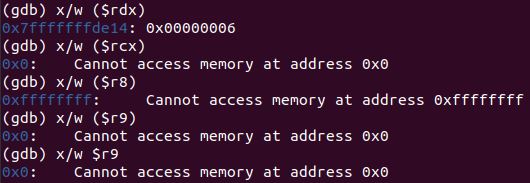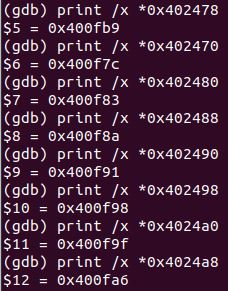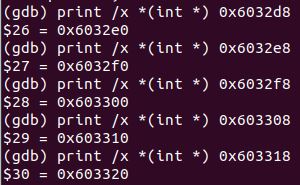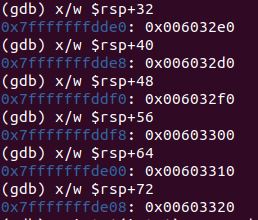「CMU 15-213」Lab(2) Bomb
Phase 1
Disassembled code of phase 1:
0000000000400ee0 <phase_1>:
400ee0: 48 83 ec 08 sub $0x8,%rsp
400ee4: be 00 24 40 00 mov $0x402400,%esi
400ee9: e8 4a 04 00 00 callq 401338 <strings_not_equal>
400eee: 85 c0 test %eax,%eax
400ef0: 74 05 je 400ef7 <phase_1+0x17>
400ef2: e8 43 05 00 00 callq 40143a <explode_bomb>
400ef7: 48 83 c4 08 add $0x8,%rsp
400efb: c3 retq
If the input equals the content at 0x402400 (which is a string), strings_not_equal will return 0 (set %eax to 0). Then after test, ZF will be set to 1 and code will jump to 400ef7. 

Phase 2
000000000040145c <read_six_numbers>:
40145c: 48 83 ec 18 sub $0x18,%rsp
401460: 48 89 f2 mov %rsi,%rdx
401463: 48 8d 4e 04 lea 0x4(%rsi),%rcx
401467: 48 8d 46 14 lea 0x14(%rsi),%rax
40146b: 48 89 44 24 08 mov %rax,0x8(%rsp)
401470: 48 8d 46 10 lea 0x10(%rsi),%rax
401474: 48 89 04 24 mov %rax,(%rsp)
401478: 4c 8d 4e 0c lea 0xc(%rsi),%r9
40147c: 4c 8d 46 08 lea 0x8(%rsi),%r8
401480: be c3 25 40 00 mov $0x4025c3,%esi
401485: b8 00 00 00 00 mov $0x0,%eax
40148a: e8 61 f7 ff ff callq 400bf0 <__isoc99_sscanf@plt>
40148f: 83 f8 05 cmp $0x5,%eax
401492: 7f 05 jg 401499 <read_six_numbers+0x3d>
401494: e8 a1 ff ff ff callq 40143a <explode_bomb>
401499: 48 83 c4 18 add $0x18,%rsp
40149d: c3 retq
Notice that<__isoc99_sscanf@plt> seems to handle our input. The format of function sscanf in C is like:
sscanf( "1 2 3 4 5 6", "%d %d %d %d %d %d", &num1, &num2, ..., num6);
rdi saves the input string, rsi stores the format string"%d %d %d %d %d %d", and rdx, rcx, r8... saves the memory addresses of the six arguments:
rdx -> rsp
rcx -> rsp + 4
r8 -> rsp + 8
r9 -> rsp + 12
rsp - 24 -> rsp + 16
rsp - 16 -> rsp + 20

 From function
From function phase_2 we can know the first number should be 1, and the rest numbers are all twice of their previous number.
Phase 3
Phase 3 takes 2 integers. The core part of phase 3 is this code:
400f75: ff 24 c5 70 24 40 00 jmpq *0x402470(,%rax,8)
jmp *means jump to the content at the address 0x402470(,%rax,8). Becasue (%rax) equals to 0x8(%rsp)(first input number) and is less than or equal to 7, here is the possible values and corresponding addresses. 
Phase 4
Notice the begainning part is similar to phase 3, it takes 2 integers and the first one should be less or equal to 0xe.
401029: 83 f8 02 cmp $0x2,%eax
40102c: 75 07 jne 401035 <phase_4+0x29>
40102e: 83 7c 24 08 0e cmpl $0xe,0x8(%rsp)
401033: 76 05 jbe 40103a <phase_4+0x2e>
Inside func4: Always try to avoid explosion and getting into another function (which makes analysis harder). So I notice if the first number is 7, it won’t go into func4 inside func4 and instead get directly out while not triggering explosion.
400fe2: 39 f9 cmp %edi,%ecx
400fe4: 7e 0c jle 400ff2 <func4+0x24>
400ff7: 39 f9 cmp %edi,%ecx
400ff9: 7d 0c jge 401007 <func4+0x39>
From the end of function phase_4, we can see if the second number is not 0, it will explode.
401051: 83 7c 24 0c 00 cmpl $0x0,0xc(%rsp)
401056: 74 05 je 40105d <phase_4+0x51>
401058: e8 dd 03 00 00 callq 40143a <explode_bomb>
40105d: 48 83 c4 18 add $0x18,%rsp
So the solution for phase 4 is 7 0.
Phase 5
Phase 5 takes a string with length of 6. The core part of phase 4 is this code (note that cl is the low 8 bits register of rcx, same as dl to rdx):
40108b: 0f b6 0c 03 movzbl (%rbx,%rax,1),%ecx
40108f: 88 0c 24 mov %cl,(%rsp)
401092: 48 8b 14 24 mov (%rsp),%rdx
401096: 83 e2 0f and $0xf,%edx
401099: 0f b6 92 b0 24 40 00 movzbl 0x4024b0(%rdx),%edx
4010a0: 88 54 04 10 mov %dl,0x10(%rsp,%rax,1)
4010a4: 48 83 c0 01 add $0x1,%rax
4010a8: 48 83 f8 06 cmp $0x6,%rax
4010ac: 75 dd jne 40108b <phase_5+0x29>
This is a loop that runs 6 times to get chars from the string we send in. ecxsaves the char (ascii code), and then and $0xf,%edxcalculates lowest 4 bits of the ascii code. movzbl 0x4024b0(%rdx),%edx: At adress 0x4024b0, there is a string that stores alphabet:  In this code,
In this code, rdxrepresents the index inside the string "maduiersnfotvbyl"and it returns the (rdx)th char. mov %dl,0x10(%rsp,%rax,1)put the char into the address (from rsp+16 to rsp+21).
4010b3: be 5e 24 40 00 mov $0x40245e,%esi
4010b8: 48 8d 7c 24 10 lea 0x10(%rsp),%rdi
4010bd: e8 76 02 00 00 callq 401338 <strings_not_equal>
From there we know the required string is "flyers" and corresponding indexes in the string "maduiersnfotvbyl"are 9 15 14 5 7. So the solution can be9on567.  The answer is not unique. As long as the lowest 4 bits are
The answer is not unique. As long as the lowest 4 bits are9 15 14 5 7, it is right (For example, IONEFGis also a right answer).
Phase 6
The last phase, like the professor said, is pretty hard. I almost spent a whole day on this.
401135: 48 63 c3 movslq %ebx,%rax
401138: 8b 04 84 mov (%rsp,%rax,4),%eax
40113b: 39 45 00 cmp %eax,0x0(%rbp)
40113e: 75 05 jne 401145 <phase_6+0x51>
401140: e8 f5 02 00 00 callq 40143a <explode_bomb>
401145: 83 c3 01 add $0x1,%ebx
401148: 83 fb 05 cmp $0x5,%ebx
40114b: 7e e8 jle 401135 <phase_6+0x41>
This loop will check if every number is sole (different from the rest).
40116f: be 00 00 00 00 mov $0x0,%esi
401174: eb 21 jmp 401197 <phase_6+0xa3>
401176: 48 8b 52 08 mov 0x8(%rdx),%rdx
40117a: 83 c0 01 add $0x1,%eax
40117d: 39 c8 cmp %ecx,%eax
40117f: 75 f5 jne 401176 <phase_6+0x82>
401181: eb 05 jmp 401188 <phase_6+0x94>
401183: ba d0 32 60 00 mov $0x6032d0,%edx
401188: 48 89 54 74 20 mov %rdx,0x20(%rsp,%rsi,2)
40118d: 48 83 c6 04 add $0x4,%rsi
401191: 48 83 fe 18 cmp $0x18,%rsi
401195: 74 14 je 4011ab <phase_6+0xb7>
401197: 8b 0c 34 mov (%rsp,%rsi,1),%ecx
40119a: 83 f9 01 cmp $0x1,%ecx
40119d: 7e e4 jle 401183 <phase_6+0x8f>
40119f: b8 01 00 00 00 mov $0x1,%eax
4011a4: ba d0 32 60 00 mov $0x6032d0,%edx
4011a9: eb cb jmp 401176 <phase_6+0x82>
This part transfer the six numbers to a array of integers (start at 0x6032d0 and save to 6 registers from rsp+32 to rsp+72). The loop in 401176 will do the job of transfering. And mov %rdx,0x20(%rsp,%rsi,2)give the value to the rsp. Pay attention to this code : mov 0x8(%rdx),%rdxand the values in the adresses :  These values are also addresses. Here is the correspondence of numbers and addresses:
These values are also addresses. Here is the correspondence of numbers and addresses:
1 -> 0x6032d0
2 -> 0x6032e0
3 -> 0x6032f0
4 -> 0x603300
5 -> 0x603310
6 -> 0x603320
For example, if the input string is"5 6 4 3 2 1", after the operation of 7 - i, it becomes "2 1 3 4 5 6". So the addresses in rsp+32 to rsp+72 are: 
4011bd: 48 8b 10 mov (%rax),%rdx
4011c0: 48 89 51 08 mov %rdx,0x8(%rcx)
4011c4: 48 83 c0 08 add $0x8,%rax
4011c8: 48 39 f0 cmp %rsi,%rax
4011cb: 74 05 je 4011d2 <phase_6+0xde>
4011cd: 48 89 d1 mov %rdx,%rcx
4011d0: eb eb jmp 4011bd <phase_6+0xc9>
This loop resets the values at adresses 0x6032d8, 2e8, 2f8, 308....
addressOf(%rsp+32)+8 = %rsp+40
addressOf(%rsp+40)+8 = %rsp+48
addressOf(%rsp+48)+8 = %rsp+56
...
Actually it gives the address saved in next register to the address in this register plus 8. You will see why the code does this in next part.
4011d2: 48 c7 42 08 00 00 00 movq $0x0,0x8(%rdx)
4011d9: 00
4011da: bd 05 00 00 00 mov $0x5,%ebp
4011df: 48 8b 43 08 mov 0x8(%rbx),%rax
4011e3: 8b 00 mov (%rax),%eax
4011e5: 39 03 cmp %eax,(%rbx)
4011e7: 7d 05 jge 4011ee <phase_6+0xfa>
4011e9: e8 4c 02 00 00 callq 40143a <explode_bomb>
4011ee: 48 8b 5b 08 mov 0x8(%rbx),%rbx
4011f2: 83 ed 01 sub $0x1,%ebp
4011f5: 75 e8 jne 4011df <phase_6+0xeb>
The last part is to check whether (rsp+n) >= ((addressOf(rsp+n)+8)). There n=32, 40, 48... and if anyone fails the bomb explodes. Actually (addressOf(rsp+n)+8) is rsp+n+8(we set this in previous part). So the condition can be rewriten as (rsp+n) >= (rsp+n+8)and our task is to make sure the integer at this address is smaller than the previous one. The following image shows the integers corresponding to the addresses:  So the right answer is :
So the right answer is :
# after 7 - i operation
3 4 5 6 1 2
# right answer
4 3 2 1 6 5
